Brand & Sons, Phillips &
Piper, Grey-Green Coaches
 The shop sign revealed in February 2015 (scroll down for more)
The shop sign revealed in February 2015 (scroll down for more)
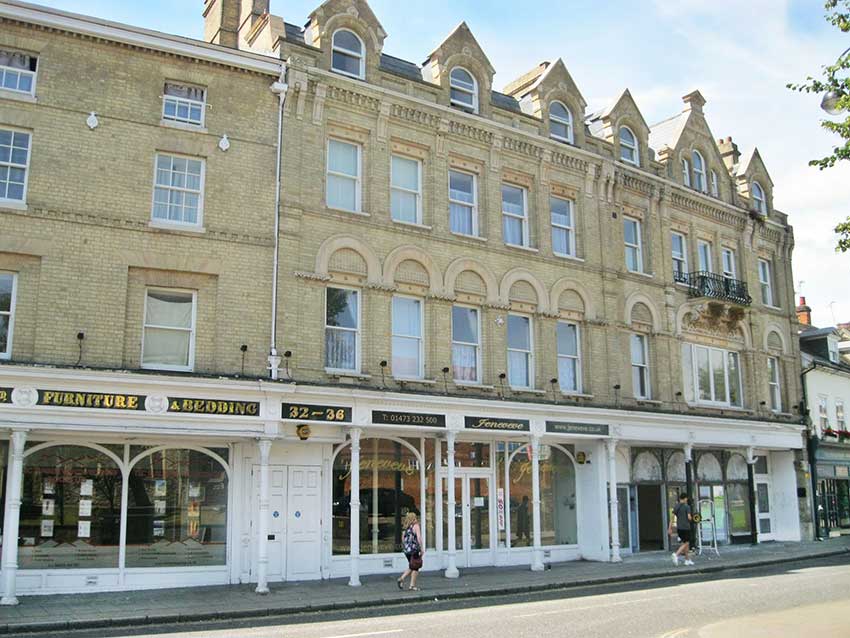 2019
image
2019
image
Above: overview of the three sections of the Brand
buildings, July 2019.
E. Brand & Sons, former department store,
32-36 Tacket Street
Once neglected and algae-covered, this building at
32-36
Tacket Street embodies several lettering examples in its fabric. Part
of the upper floors were once devoted to the First Floor night club;
the shops below have changed hands many times, but once
belonged
to 'BRAND & SONS' as shown on the
decorative panel below the ornate
balcony. The supporting stone corbels supporting the balcony are a
little like ship's prows with their human faces and the ampersand of
the company name slides below the central one. Blocked gutters have
caused staining, moss and algal growth from time to time.
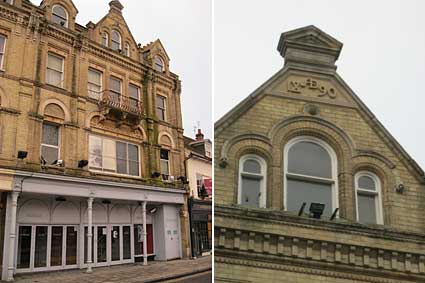 2011 images
2011 images
The owners of The Opium Lounge/Buddha Bar - later Ice
and Fire -
refurbished
the building in 2001 and cleaned the excellent decoration. One puzzle:
the
date stone high up in the gable (above right) appears to be
clearly marked 'IX
AD 90'; to us this reads '990', but the
building
surely dates from 1890 when Mr Brand and his sons operated a sizeable
business in selling drapery, stays and corsets. [UPDATE
16.8.2012: The answer comes from Simon Knott (of the Suffolk
churches website; see Links), whose close-up
of the date shows that the 'X' is really a fancy '8' with squared-off
top and bottom, so '1890' it is, then. One for the architecture buffs:
we also learn that the smiley balcony supports are called 'telamons',
being (although rather small) a male version of the 'caryatid' as seen
in Cheltenham's Montpellier area.
Telamon, in
Greek mythology, was the son of Aeacus of Aegina and Endeis; he
accompanied Jason and his Argonauts in search of the Golden Fleece.]

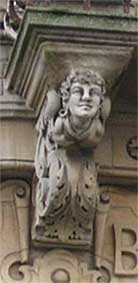 Telamon
Telamon
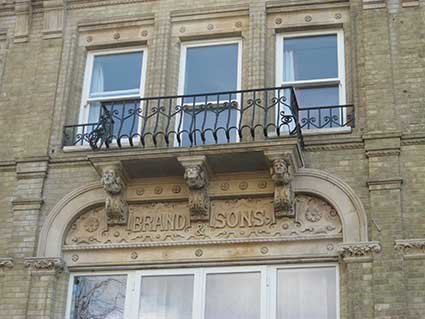 2018 images
2018 images
Above and below: following the cleaning
and conversion of the buildings
into accommodation in 2017, the fine balcony and decorative lettering
are seen to best effect:
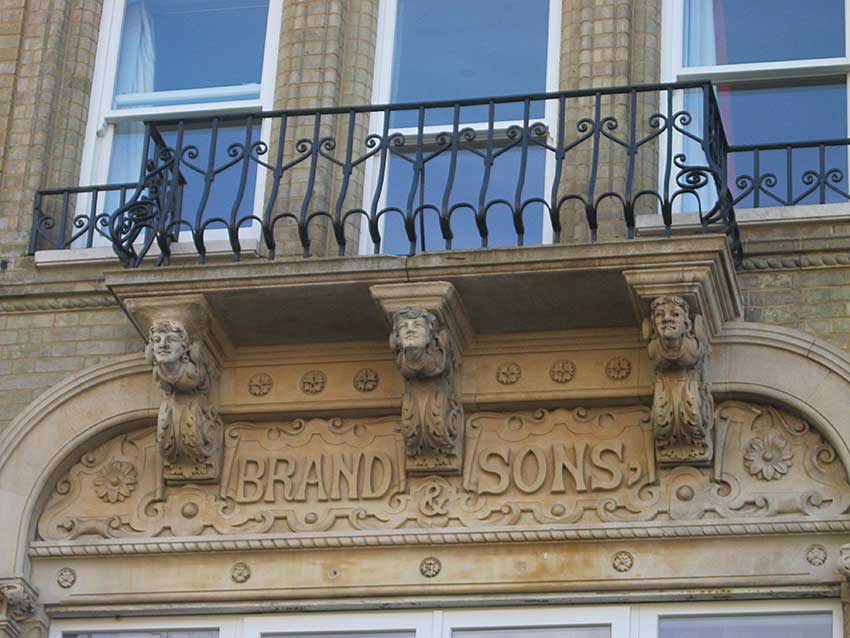
Below: Telamons up close and personal
after the building was cleaned. The eyes at extreme left and extreme
right are particularly beady, perhaps due to erosion of the stonework.

Below: for comparison, we can go to the Baroque architecture
of south-east Sicily. This example comes from the street Via Corradoro
Nicolaci in the town of Noto, one of Sicily's UNESCO World Heritage
Sites. The 'pregnant' balcony railings show the characteristic outward
bulge, said to have been designed to accomodate the full skirts of the
women. The Brand building balcony has an echo of this bulge in its
railings. This example has winged female corbels. Sometimes the
carvings seen in Sicily have recognisable portraits of local
characters, or grotesque figures.
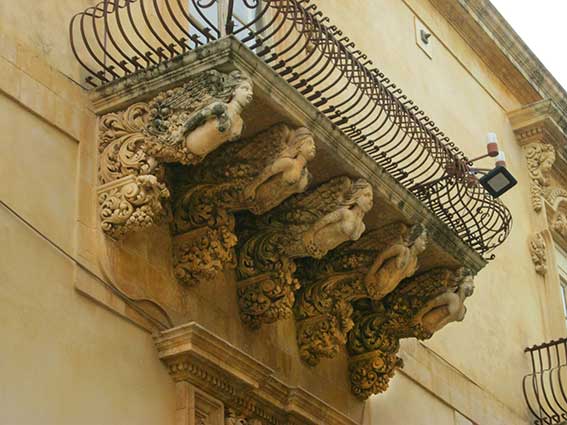 2019 image
2019 image
The capital stone at top left of the
building adjacent to one which dates the fascade to 1875 - shows 'E.B' for E. Brand.
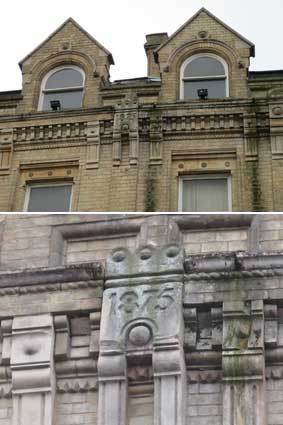
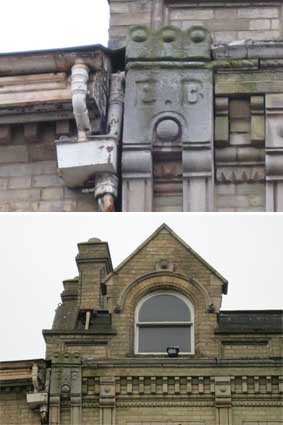
The making of stays (corsets) was an important local
industry for many years in Ipswich, the piecework
manufacture being done in people's homes. In
1830 Ipswich
had at least nine staymakers, six of them women, this rose to thirteen
by 1845. At the beginning of the twentieth century there were only two
women listed as corsetmakers, but three companies: the Atlas Corset Co.
in Lower Orwell Street, E. Brand & Sons in Tacket Street and
William Pretty & Son in the large
factory with its high chimney on
Tower Ramparts which employed hundreds of women. Pulled down in the
eighties, this last site is now the public car park running behind
Debenhams, All Fired Up (the stabling at the back of the Crown & Anchor Hotel) and Marks
& Spencer.
 2011
images
2011
images
'AD 1890
E. B 1875
BRAND & SONS,'
Overview of the Brand buildings
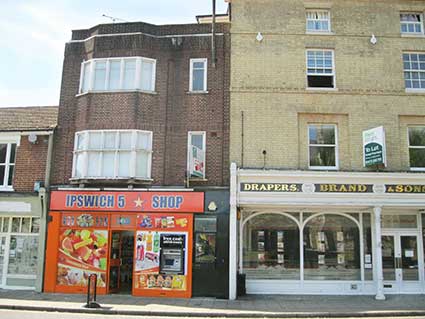
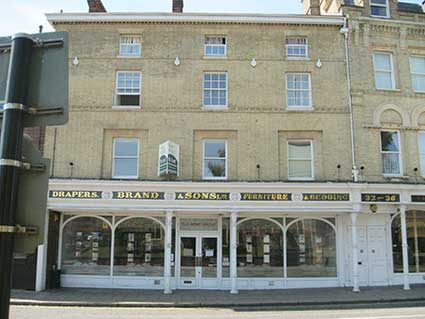 2019 images
2019 images
Cake Supreme is no. 42; the Ipswich 5 grocery shop is no. 40 Tacket
Street. TLS Home Group (building) is
at no. 38 (beneath the the mirrored signs).
Brand's store is 32 to 36.
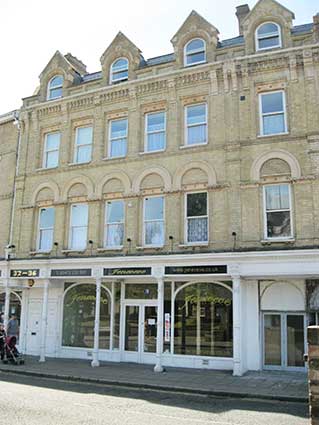
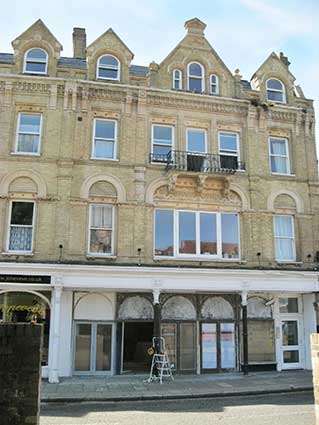

The former Jeneveve dress shop is no.
30. The section with the
balcony is no.
28. Jonty's
clothing shop is at no.
26.
Brand & Sons was a drapery, haberdashery and corsetry department
store, and they also let upper rooms to the labouring classes. The
premises were extensively rebuilt in 1903 by the architect Walter
Brand, son of the store owner. See Ipswich
Museum contents for a mirrored name-sign belonging to the Brand
& Sons department store. By September 2014 the paint above
the central entrance door to the former store was starting to peel
away, mainly because it had been applied to glass with mirrored
characters similar to the Museum's sign;
'32–36'
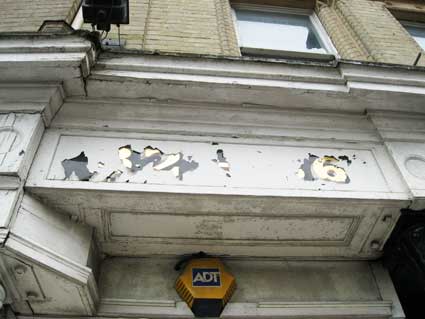 2014 image
2014 image 
The rest of this signage above the shop windows is weathering at
a slower pace, but there are traces of gold and black lettering showing
through there, too.
[UPDATE:
16.2.2015: "Walking along Tacket St today saw some fellas working on a
shop frontage, has been wedding outfitters most recently, but they were
standing with admiration looking at some of the most gorgeous
lettering, in superb condition after they had scraped paint away.
'DRAPERS. BRAND &
SONS LTD.
FURNITURE & BEDDING (34-36)'
Look, the last section about to be scraped away! Tony Marsden" Our grateful thanks to eagle-eyed Tony
Marsden, who not only spotted the revealed lettering, but had his
camera handy. Is there any chance that the mirrored lettering might be
left in view by the next occupiers? – see press cutting below]
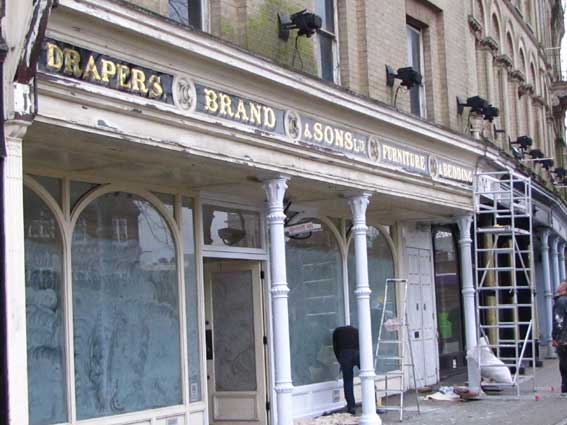
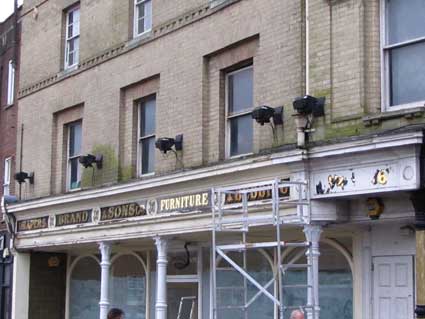 2015 photographs courtesy Tony Marsden
2015 photographs courtesy Tony Marsden
[UPDATE 20.2.2015: It is good
to see that the local paper, the Ipswich
Star, covered the story on the following day. From this article
we learn that the owner of Peggy's Place, the new occupant of the shop,
has said: 'Since the sign was exposed I've had several calls from
people saying how wonderful it looks and can we keep it that we think
it would be good to keep it showing.' Result. The E. Brand & Sons
store sold drapery, haberdashery and furniture from 1903 until the late
1950s when it closed.]
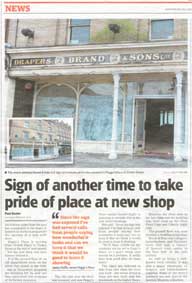 Star,
17.2.2015
Star,
17.2.2015
 2015 image
2015 image
What we need now, is for the right-hand side of the building to
be restored so that we can see what lettering lies below the paint on
that side....
In the summer of 2016 this shop was vacated and stood empty once
again. The resonant Brand & Sons Ltd sign remains, as it did for
many years beneath coats of paint.
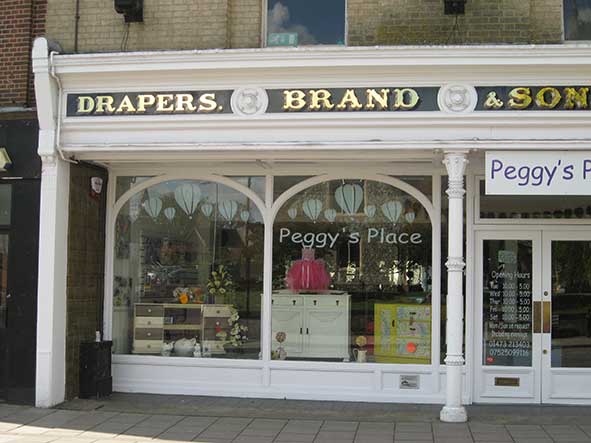 2016 images
2016 images
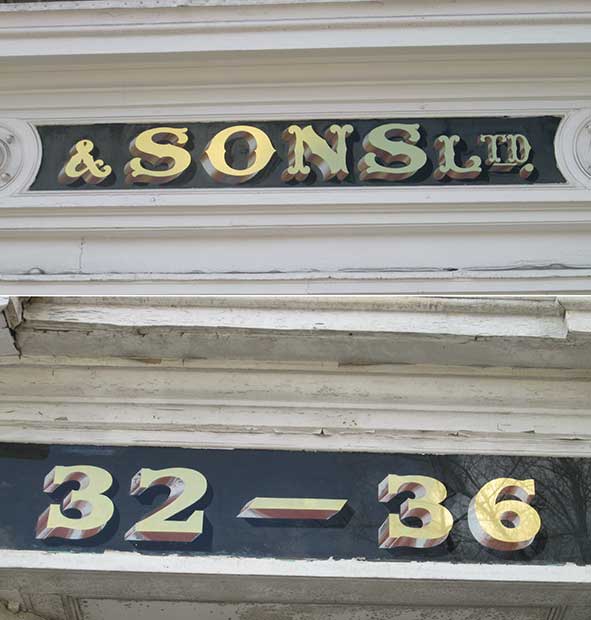
[UPDATE 20.8.2019: The
exposure of the mirrored lettering on the Brand building continues.
Suddenly we saw, for a few days, the (somewhat surprising) word
'FRIENDLY' with the
removal of the first 'Jeneveve' shop sign- board (showing the telephone
number). Does the next panel read 'SERVICE'? The board was quickly
reattached and painted over. Note the plainer numerals and capitals
compared to the '& SONS' which show the flair of the fairground in
their design. [continues]
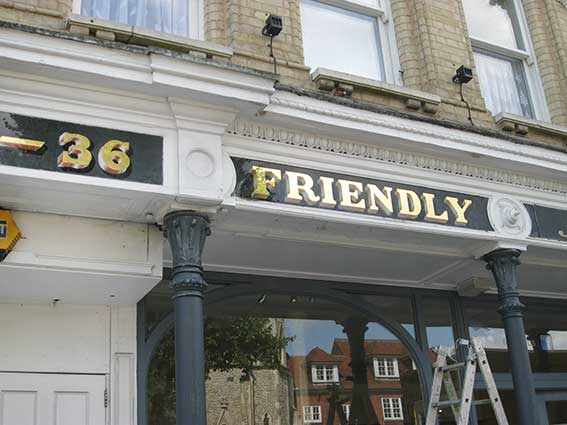 2019 images
2019 images
The close-up shows that the mirrored glass has cracked
across the letter 'F'. Reflected in the signs and shop window: Christchurch URC Church, as well as the
surrounding trees and buildings. [continues]
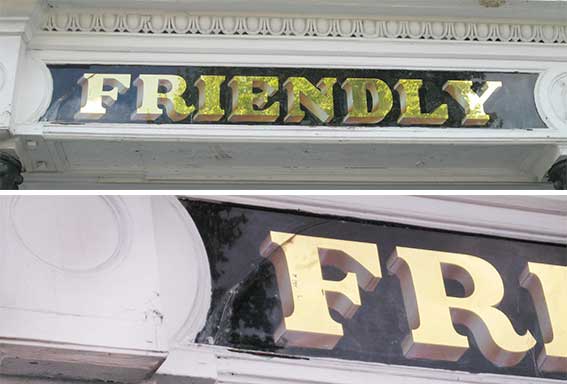
At the far right (west end) of the shop, work to clean up the
shop unit included partially removing the paint layers with hot
air strippers. This resulted in the westernmost glass panel (just)
showing
the word ('DRAPERS.') under smeared green paint. If they'd used blade
scrapers on the paint layers, it might have
come off cleanly. The first two panels
remain unreadable and it is likely that this is the last we shall see
of the Brand company lettering here. The greenish 'DRAPERS.' sign also
indicates the
damaged nature of the mouldings above it.]
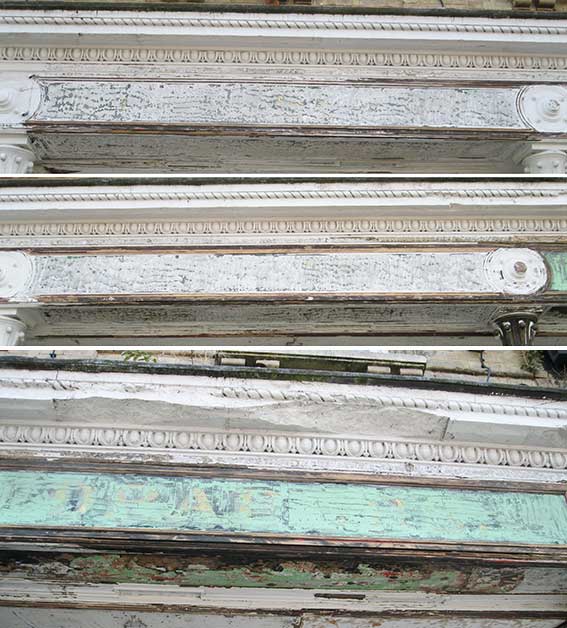
The complete original sequence, apart from one unknown panel,
runs:
'DRAPERS. | BRAND | &
SONS LTD.
| FURNITURE | & BEDDING |
34–36 | FRIENDLY |
[SERVICE?] | [?] | FURNISHERS |
JOHN BLUNDELL |
DRAPERS.' [see update
below]
and we can only hazard at the one remaining unknown panel, but
from
trade directories we can guess at: 'Hosier', 'Haberdasher',
'Warehousemen' – or repeats of the 'Furniture' and 'Bedding' signs from
the eastern end.
 Courtesy The Ipswich Society
Courtesy The Ipswich Society
[UPDATE 18.12.2019: this
photograph of the westernmost part of the former E. Brand & Sons
store was found on The Ipswich Society Image Archive (see Links), dated May 1977. Blundell's restoration
of the shop front, fascia etc. was nominated for an Ipswich Society
Conservation Award in that year. The crucial thing for this website is
the revelation that the three panels above the shopfront read:
'FURNISHERS. JOHN BLUNDELL DRAPERS.'
Unfortunately, due to reflection the two panel to the left of these are
unreadable here, but the word 'FRIENDLY' beyond can just be made out.
John
Blundell was clearly a clothing shop, with some lighting and furnishing
stock, perhaps. From the Kelly's
Directory research shown below, it appears that the John
Blundell company must have moved into this shop at some time after 1956
when the Brand store was split into smaller businesses. Perhaps more
suprising is the mirrored lettering above, which must have been changed
to mark the new business post-'56. Not quite what we expected, having
assumed that the Victorian signs remained unchanged since the heyday of
Brand's. The soot and grime from the height of coal-fire use has
resulted
in the dark grey facade above shop level – compare with the cleaned
building at the top of the page.]
[UPDATE June 2017: the
E. Brand building being cleaned and converted into accommodation by
the new owners.]
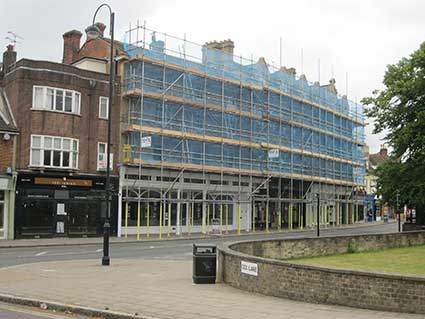 2017 image
2017 image
[UPDATE 5.7.2019: I was
delighted to stumble upon the beautiful photos and information about
the Brand & Sons shop front in Tacket Street, Ipswich – and to
find that is still there!
The shop was established by Edward Brand, and his wife Harriet, who
were my Great-Great Grandparents, soon after they married in
1866. They were originally from Cambridge, and were both drapers. They
had wanted to set up business in London, but Edward’s health was not so
good, and he was advised that he should be somewhere where the air
quality was better. They therefore set up their drapery business in
Ipswich, using all their savings to buy the premises. The shop
I believe, from a family story that has been handed down to me,
was initially signed as ‘Edward Brand’.
Later, two of their sons, Sydney and (Edward) Pumfrett Brand went
into the family business. Walter, the other son, had no interest in the
business and went on to become an architect. This is when
the business was re-named to ‘Brand & Sons’, which was in
around 1890, I believe. Pumfrett died in 1894, leaving Sydney to
run the business after his father, Edward, retired. Edward died
in 1904. I do have a photo of Edward. You are very welcome to use both
the photo and the information that I have given you if you would like
to – it is only by this sort of collaborative effort that we are able
to find out much of the historic information about our forebears!
Both Edward, and later Sydney, served as Borough Councillors for
several years in Ipswich and Sydney Brand was Mayor of Ipswich in
1915-16. He died in 1927. I am not certain if any other members of
the family continued to run the business after this time: your website
mentions that the shop didn’t close until the 1950s.
Looking back at some of the other records I have, I also noticed on
Walter Brand’s birth certificate that in 1872, the address is given as
36 Tacket Street. Later, in 1901, William Stanley (another son, who I
believe was involved in the business for a short time) was living at
28-36 Tackett Street, with around 30 other people at the address, all
of whom had their occupations given as draper’s assistants; so I would
presume that these people were working within the business as well. The
change of address from just no. 36 Tacket Street in 1872 to 28-36 in
1901 would certainly match with the idea that as the business grew, the
building was in some way extended.
At some point I will have to take a trip to Ipswich to see the building
for myself, but in the meantime, your website has really given me a
flavour of what the shop might have been like. Kind regards, Anne
Marshall.]
Many thanks to Anne
for helping to flesh out the story of this company and building. The
vignetted portrait of the founder of the company is as atmospheric as
many Victorian/Edwardian studio photographs. Mr Brand gazes off to the
left, dressed in his smart clothes bespectacled and splendidly
bewhiskered.
We are particularly grateful
for the additional information about the founding couple who were both
drapers. The information we gleaned from random sources gave little
insight into the beginning of the business. We had always assumed that
the more decorative westerly part was built on the site from scratch,
then the plainer easterly part was added as the business grew, designed
by the architect son, Walter, in 1903. It is possible that Edward and
Harriet Brand bought an existing building on the site and had the
westerly facade remodelled to include the ‘E. Brand & Sons’
lettering etc. in 1890 (the date shown on the apex of the gable).
Researches at Suffolk Record Office
The first record of E. Brand we’ve found is in J.G. Harrod’s Directory of Suffolk &
Cambridgeshire, 1873. There is a simple entry for: ‘BRAND
EDWARD, linen draper, hosier, and haberdasher, Friendly House, 34 and
36, Tacket Street.’
By Stevens Directory of
1881the description is ‘general draper, silk mercer and warehouseman.
Friendly House, 32, 34 and 36, Tacket Street. Family mourning. Funerals
furnished. (See Advt.)’. The full page advertisement, in a variety of
fonts and sizes reads:
FRIENDLY HOUSE,
32, 34, & 36, TACKET STREET,
Extending through to Wingfield Street
EDWARD BRAND
GENERAL DRAPER
Mourning & Furnishing
WAREHOUSEMAN,
Has always an extensive Stock of New Goods in all
Departments of the House.
_______
Our Celebrated Dacca Calicoes
LONGCLOTHS AND SHEETINGS,
Are said to the Best in the World for Strength, Soft-
ness and Durability.
=======
All goods bought and sold for Cash at Lowest Current
Market Prices and guaranteed to be what they are represented.
WHOLESALE & RETAIL.
YOUR INSPECTION INVITED.
=======
EDWARD BRAND, IPSWICH.
The above advertisment definitely suggests that the shop is a modest
form of 'department store' – an expression which emerged in the
mid-19th century with Le Bon Marché in Paris in 1852 and later
Whitely's store in London.
Stevens Directory of 1894
gives the address as 28, 30, 32, 34, and 36 Tacket Street and the
description: ‘wholesale & retail draper & complete house
furnisher’.
Kelly’s Directory of 1906:
‘Brand & Sons, drapers 28, 30, 32, 34, 36 and 38 Tacket Street;
factories, Wingfield Street.’ This is the first description found of
the
company with the ‘& Sons’ and the longest address, suggesting that
they steadily bought up neighbouring premises to expand ‘Friendly
House’. This entry is also the first to add the word 'factories' in
regard to the buildings extending to [Little] Wingfield Street (see the
1902 map on our Tooley's Almshouses
page). It can be assumed that the 'factories' accessed from the rear of
the Brand buildings were making corsets (although none of the trade
directories we've seen refer to the corsetry trade).
Kelly’s Directory of 1909: has
a similar entry, but note also that 24 Tacket Street is listed as
‘Brand
& Sons, hardware dealers’. The business must have been flourishing
to diversify into very different merchandise. Perhaps one of the sons
wanted a new challenge and Edward agreed to set up this business under
the family company name.
Kelly’s Directory of 1935
shows E. Brand & Sons at the same address (28-38) with a full page
advertisement describing the business as ‘DRAPERY & FURNITURE,
bedding manufacturers & general warehousemen’. They are described
only as ‘drapers’ at 28-38 Tacket Street by 1952.
The last entry in Kelly’s for
E. Brand & Sons is in the 1954 volume. By 1956 a number of other
businesses are being run from 28 through 38 Tacket Street.
Sadly, there are no engravings in the directories we consulted showing
the exterior of the buildings, which would have aided identification of
the full run of signs above ground floor level.
[UPDATE 17.3.2010:
Sadly, the new proprietors in the Brand buldings have seen fit to
obliterate all the mirrored trade signs above the shopfronts, leaving
only the street numbers '32-36' over the entrance.]
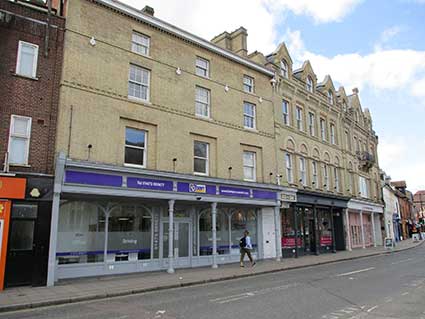 2020 image
2020 image
Phillips & Piper, St Margarets Street
A similar naming of a business in the fabric of the
building can be found
at the modest entrance at the corner of Pipers Court in St Margarets
Street.
In the photograph below it is just below the traffic lights. The large,
curving apartment block which straddles the site of the
town
ramparts between that street and Old Foundry Road was, until the
eighties,
a busy factory producing sports clothing:
'PHILLIPS & PIPER LTD
CHRISTCHURCH WORKS'
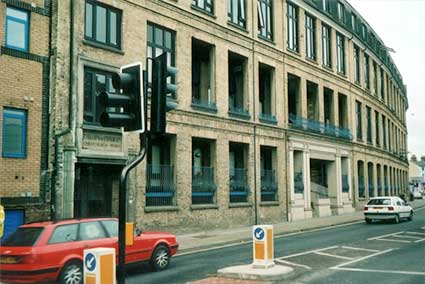 2004 image
2004 image  2015 image
2015 image
One hundred and thirty one years of history came to a close in
June 1982, when Phillips and Piper closed its Ipswich clothing works.
The company made high quality clothes, including riding wear for men,
women and children. Thousands worked for the company during its
history, many of them young women who started directly from school.

Above: the deeply chiseled, stylish characters.
It is only a short distance from Christchurch
Mansion
and Park; it's also halfway between Ewers Grey-Green (below) and The
Milestone.
 1932
image
1932
image
Above: Phillips & Piper Ltd.: No. 1 Machine Room –
massed ranks of sewing machines and, almost exclusively, female workers
(a foreman stands in the left distance).
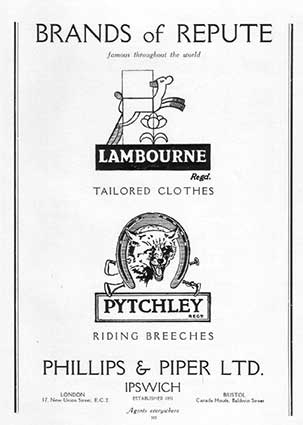 1936
advertisement
1936
advertisement
Ewer's Grey-Green Coaches, St Margaret's Street/Old Foundry Road
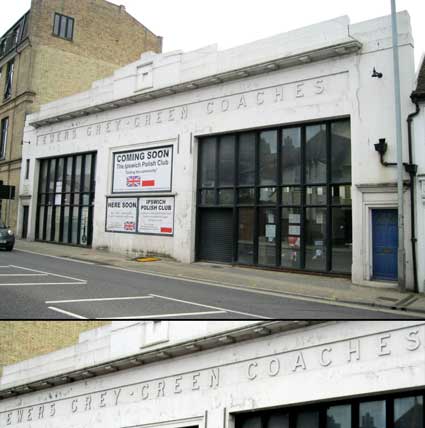 Entrance on St Margaret's
Street / 2012
images
Entrance on St Margaret's
Street / 2012
images
The former Grey-Green Coaches depot has large
concertina doors onto both
St Margaret's Street and Old Foundry Road. Below is the view from the
Public
Library's
Lecture Hall entrance on Old Foundry Road; the front entrance carries
similar
lettering stretched in a single line. The modest art deco style of the
building
is well preserved. We can remember travelling in Grey-Green coaches
from
London to Saxmundham in the seventies and, amongst many pauses and
stops,
we pulled into this barn-like building as we paused in Ipswich (the
coaches
used to travel down all sorts of unsuitable roads in those days
including
a two-way Woodbridge Thoroughfare). These days the route is covered by
National
Express coaches which stop at the Old Cattle Market Bus Station. This
spot
would be far too congested with traffic most of the time to use the
Grey-Green
depot. In recent years the building has been used by a taxi company,
car dealer and auction house. The company was started in 1928 by George
Ewers and ran express coaches from Ipswich and Felixstowe to London as
well as coach outings in the famous 'Grey Greens'. After the coaches
stopped coming through, seven lorryloads of ready-mixed cement were
required to level the floor which dropped from St Margaret's Street to
Old Foundry Road in order to facilitate water run-away when the coaches
were washed.
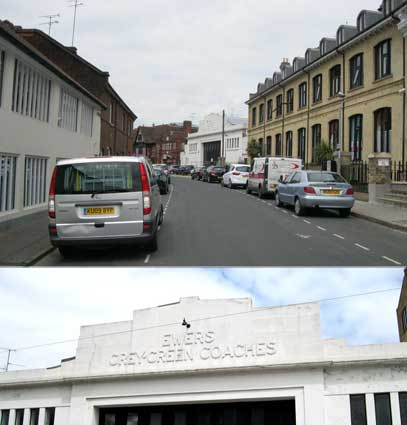

The Grey-Green Coaches garage is the 'properly Modern' work of
versatile architect J.A. Sherman in 1937, who designed much hereabouts
including the next door eclectic group on buildings including the
former 'Bar Fontaine' and the Art Deco number
1 Woodbridge Road, dated
'1928'.
The photograph below shows the coach station when in operation
in 1982, with the lettering picked out in green. The crane in the
background could well
be being used to build Crown Pools in Crown Street at this time.
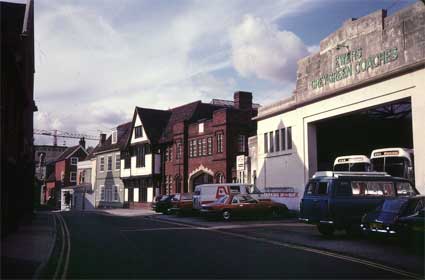 Photograph courtesy The Ipswich Society
Photograph courtesy The Ipswich Society
In 2013 on a visit to the Ipswich
Transport Museum we discovered a fine advertising board for
Grey-Green Coaches.
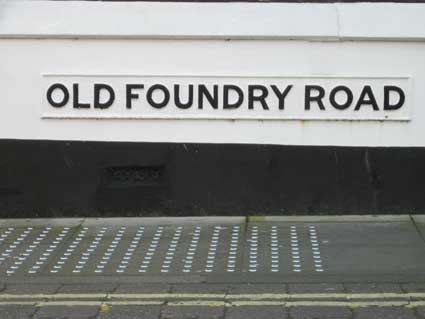 Sign,very
low down, on Northgate St junction
Sign,very
low down, on Northgate St junction
This part of the Ewers building stands on the historic
Old
Foundry Road (itself
commemorating the original Robert Ransome foundry – see our
blue plaques page – which was the start
of
the Ransome's engineering empire, so central to the history of Ipswich.
See also the
last vestiges of the 'Ransomes' name in Wyke's
Bishop
Street and the Orwell Works site.
Old Foundry Road follows
the line of the Rampart and Town Ditches round the medieval core of the
town. Since a good repair and cleaning job in Spring 2004, the Ewers
building
presents a much crisper countenance to the world.
It faces the 'Lectures'
entranceway to the old
Central (now 'County') Library.
See the 1778 map of the North Gate area on our Bethesda page.
Home
Please email any comments and contributions by clicking here.
Search Ipswich
Historic Lettering
©2004 Copyright
throughout the Ipswich
Historic Lettering site: Borin Van Loon
No reproduction of text or images without express written permission


 2019
image
2019
image 2011 images
2011 images

 Telamon
Telamon  2018 images
2018 images

 2019 image
2019 image

 2011
images
2011
images

 2019 images
2019 images


 2014 image
2014 image 

 2015 photographs courtesy Tony Marsden
2015 photographs courtesy Tony Marsden Star,
17.2.2015
Star,
17.2.2015 2015 image
2015 image 2016 images
2016 images
 2019 images
2019 images

 Courtesy The Ipswich Society
Courtesy The Ipswich Society 2017 image
2017 image
 2020 image
2020 image 2004 image
2004 image  2015 image
2015 image
 1932
image
1932
image 1936
advertisement
1936
advertisement Entrance on St Margaret's
Street / 2012
images
Entrance on St Margaret's
Street / 2012
images

 Photograph courtesy The Ipswich Society
Photograph courtesy The Ipswich Society Sign,very
low down, on Northgate St junction
Sign,very
low down, on Northgate St junction